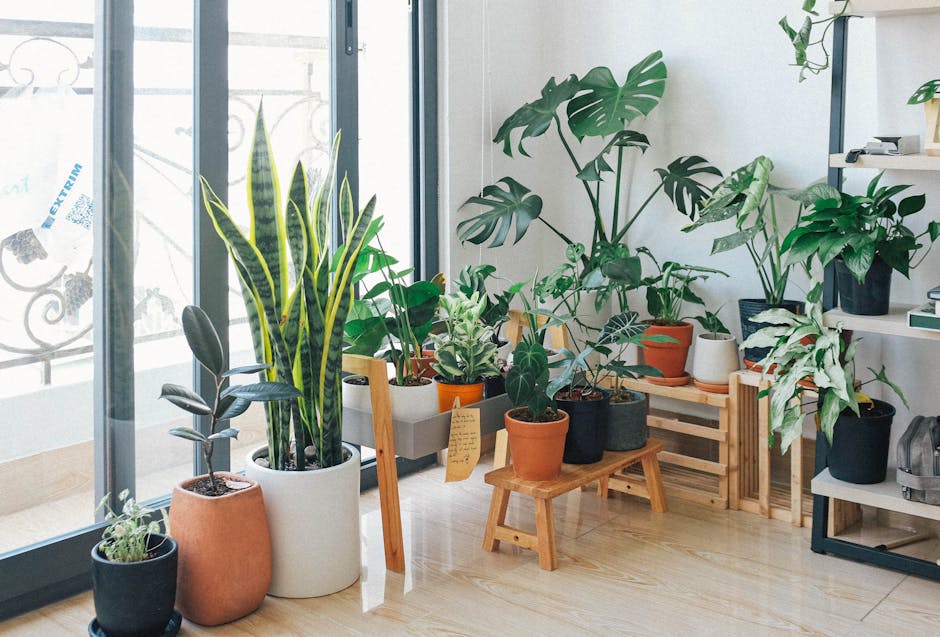The Alchemy of Air: Breathe New Life with Indoor Plants
When we think of creating a healthy home environment, we often overlook one of the simplest and most effective solutions: indoor plants. Did you know that certain plants can purify the air and elevate your mood all at once? This article explores the transformative power of indoor plants for sustainable living. You’ll learn how to create a breathable home filled with greenery, not just for aesthetics but as a healing retreat from the modern world's pollution.
Why Indoor Plants?

In today’s fast-paced world, we might not realize how much indoor air pollution affects our health. The air inside our homes can be more polluted than the air outside, and because we spend so much time indoors, this can have grave consequences for our health and well-being. According to a study by the Environmental Protection Agency (EPA), indoor air quality is a significant concern that people need to address.
Enter indoor plants. Not only are they beautiful and an easy way to bring the outdoors in, but they also offer tangible health benefits. Indoor plants can significantly reduce carbon dioxide levels, increase humidity, and remove toxins from the air. When you integrate greenery into your home, you aren't just beautifying your space; you’re creating a healthier living environment.
The Science Behind Air Purification

Ever wondered how indoor plants purify the air? The process involves several fascinating mechanisms, including photosynthesis and transpiration. During photosynthesis, plants absorb carbon dioxide and release oxygen, which can improve air quality substantially. According to research published by NASA, certain plants can even remove volatile organic compounds (VOCs) typically found in household products.
Plants convert harmful substances into less harmful ones. For example, a spider plant can absorb formaldehyde, while a peace lily tackles benzene and trichloroethylene. The more you know about plant functions, the more empowered you'll feel to create your own green oasis.
Selecting the Right Indoor Plants

To maximize the benefits, selecting plants that purify air and suit your lifestyle is essential. Here are some popular options:
1. Spider Plant (Chlorophytum comosum)

The spider plant is not only easy to care for but also effective at removing pollutants such as formaldehyde and xylene. Its long arching leaves bring a sense of tranquility and can flourish in a range of light conditions.
2. Snake Plant (Sansevieria trifasciata)

Often touted for its air-purifying qualities, the snake plant is resilient and can thrive in low light. It absorbs toxins during the night, making it ideal for the bedroom.
3. Peace Lily (Spathiphyllum)

If you want an aesthetically pleasing plant, look no further than the peace lily. It’s not only beautiful with its elegant white blooms but also excels at filtering out harmful compounds. Just be cautious; it’s mildly toxic to pets.
4. Bamboo Palm (Chamaedorea seifrizii)

A fantastic choice for those needing high humidity, the bamboo palm is excellent at filtering out benzene, formaldehyde, and trichloroethylene. Not to mention, it adds a tropical vibe to any room.
5. Boston Fern (Nephrolepis exaltata)

Known for its lush, feathery leaves, the Boston fern is a champion at removing indoor air pollutants. It thrives in humid conditions, making it suitable for places like kitchens and bathrooms.
By choosing the right plants for your space, you can optimize air purification and elevate your home’s aesthetics.
Creating Your Indoor Sanctuary

Now that you've selected the plants that suit your needs, how do you arrange them to create a soothing, inviting atmosphere?
1. Find the Right Spots

Sunlight is a crucial element in plant care. Identify areas in your home that receive adequate sunlight and position your plants accordingly. If you are short on light, consider hardy options like the snake plant that can thrive in lower light conditions. You can also explore the art of biophilic design—a concept that focuses on connecting the inhabitants of a space to nature.
Check out our article on biophilic design to learn how to enhance your home's well-being through nature.
2. Grouping Plants

Grouping plants can amplify their visual impact while also creating microclimates that benefit their growth. Use plant stands, shelves, or window sills to create layers and differing heights. Combining plants with varying leaf shapes and colors can add visual interest.
3. Decorative Pots

Choosing the right pot makes a significant difference. Opt for pots that are stylish yet functional. Ensure they have drainage holes to prevent root rot. You might even consider DIY pots from upcycled materials—a fantastic way to combine creativity with sustainability. For tips on upcycling, see our guide on transforming waste into wonder.
4. Regular Maintenance
Regular maintenance is key to keeping your indoor garden thriving. This includes watering appropriately, dusting leaves to allow efficient photosynthesis, and periodically repotting plants for healthy growth. Remember, overwatering is a common mistake; always check the soil moisture before watering.
The Psychological Benefits of Indoor Plants
Now let’s dive deeper into why we should care about plants beyond just air purification. Studies have shown that the mere presence of plants can enhance mood and cognitive function. The green color of plants is calming—a natural stress reliever in our fast-paced lives.
A recent article in Harvard Business Review highlighted the correlation between workplace productivity and plant presence—a testament to how vital greenery is for mental well-being. Whether at home or in the office, nurturing plants provides a sense of responsibility and achievement, enhancing overall happiness and reducing anxiety.
In times of stress, walking through your indoor jungle can provide a quick mental reset. A little nurturing not only nurtures the plants but can also serve as a grounding and meditative experience for you.
Seasonal Care Tips
With changing seasons, your plants will have different needs. Here are some seasonal care tips:
Spring and Summer
- Fertilize: Plants tend to grow actively during these seasons. Use organic fertilizers to provide them with the necessary nutrients.
- Repot: Check if your plants need bigger pots. Healthy root growth is crucial as they get more substantial.
Fall and Winter
- Reduce Watering: Many plants go into dormancy during the colder months, needing significantly less water.
- Consider Lighting: As daylight hours shrink, consider placing grow lights to ensure your plants receive enough light.
Using an expected seasonal approach will help your plants thrive, ensuring you enjoy their benefits year-round.
Going Further: A Holistic Approach to Sustainability
Indoor plants are just one aspect of a sustainable lifestyle. Consider expanding your eco-friendly practices throughout your home. From embracing energy-efficient appliances to exploring zero-waste solutions in your kitchen, the journey towards sustainability can be profound and transformative.
For in-depth strategies, explore our post on 10 easy swaps for a zero-waste kitchen. These small adjustments not only benefit the planet but enhance the quality of your home life as well.
Integrating Technology Wisely
In modern living, integrating technology with sustainability can yield remarkable results. Smart home devices can regulate humidity, temperature, and light levels to ensure optimal growth conditions for your indoor plants. Sensors that notify you when to water, clean air purifiers, and smart thermostats can lead to a more eco-friendly living space.
Additionally, consider the unseen impact of home electronics, as discussed in our resource on eco-friendly alternatives. Transitioning to energy-efficient appliances can further reduce your carbon footprint and enhance indoor air quality.
Final Thoughts
Crafting a breathable home filled with indoor plants is not just about aesthetics—it’s about creating a sanctuary for your mind, body, and spirit. The inclusion of intelligent indoor plants can purify the air, enhance your mood, and promote overall well-being.
By getting to know the best plants for your living space, integrating them thoughtfully, and adopting a holistic approach to sustainability, you can create a green oasis that benefits both your health and the planet.
So, are you ready to take a breath of fresh air in your home? You have the tools and knowledge—now it's time to let nature in!



